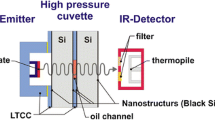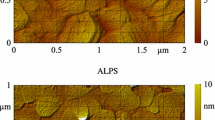Abstract
It is suggested that chemical and heat treatment of surfaces under moist conditions (including also chemical assembly of a surface by molecular layering) and gas-cutting be used to fabricate silicon on insulator structures to obtain silicon wafer surfaces with prescribed chemical composition, activation, and surface modification.
Similar content being viewed by others
REFERENCES
V. F. Reutov and Sh. Sh. Ibragimov, “Method for fabricating thin silicon wafers,” USSR Inventor's Certificate No. 1282757, December 30, 1983.
Z. Yu. Gotra, Handbook of Technology of Microelectronic Devices, Radio i Svyaz', Moscow (1991).
M. Bruel, “Smart-cut technology: basic mechanisms and applications NATO,” in: Proceedings of Conference on Advanced Research Workshop: Perspectives, Science, and Technologies for Novel Silicon on Insulated Devices, Kiev, October 12-15, 1989, Vol. 1, p. 9.
E. P. Prokop'ev, S. P. Timoshenkov, A. L. Suvorov, et al., “Special features of the technology for fabricating silicon on insulator structures by direct bonding of silicon wafers and monitoring their quality,” Preprint 24-00, Institute of Theoretical and Experimental Physics (2000).
A. L. Suvorov, Yu. A. Chaplygin, S. P. Timoshenkov, et al., “Analysis of advantages, prospects for applications and technologies for producing silicon on insulator structures,” Preprint 27-00, Institute of Theoretical and Experimental Physics (2000).
W. Maszara, G. Goetz, A. Cavigilia, and J. Kitterick, “Bonding of silicon wafers for silicon on insulator,” J. Appl. Phys., 64, No. 10, 1943-1950 (1986).
R. Stengl, T. Tan, and U. Gosele, “A model for silicon wafer bonding process,” ibid., 28, No. 10, 735-741 (1989).
Sensor Technology Devices, Artech House, Boston (1994), pp. 157-201.
V. B. Alekskovskii, Chemistry of Supermolecular Compounds, Izd. St. Petersburg. Universiteta, St. Petersburg (1996).
Q. Tong and U. Gosele, “A model of low temperature wafer bonding and its applications,” J. Electrochem. Soc., 143, No. 5, 1773-1779 (1996).
Q. Tong and U. Gosele, “Wafer bonding and layer for microsystem,” Adv. Mater., 11, No. 17, 1409-1425 (1999).
Q. Tong and U. Gosele, Semiconductor Wafer Bonding: Science, Technology, John Wiley, New York (1988).
V. P. Popov, “Production of silicon on insulator structures for ultralarge integrated circuits,” Izv. Vyssh. Uchebn. Zaved. Élektron., No. 5, 22-26 (1998).
Author information
Authors and Affiliations
Rights and permissions
About this article
Cite this article
Suvorov, A.L., Grafutin, V.I., Zaluzhnyi, A.G. et al. Silicon Wafer Bonding by Chemical Assembly of a Surface by Molecular Layering and Gas Cutting. Atomic Energy 91, 793–800 (2001). https://doi.org/10.1023/A:1013888021077
Issue Date:
DOI: https://doi.org/10.1023/A:1013888021077




